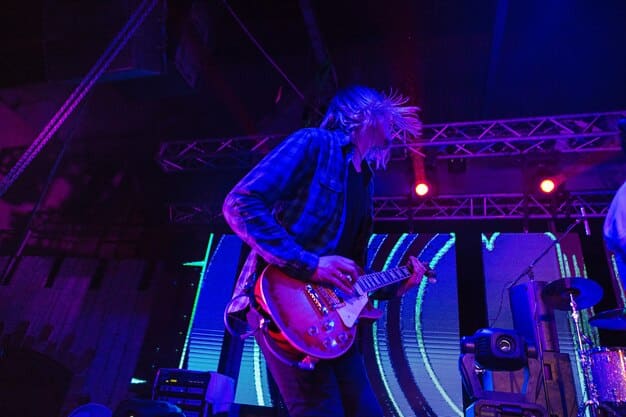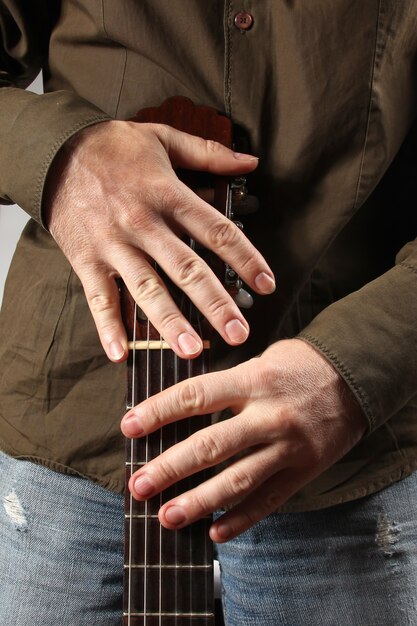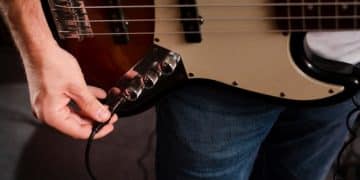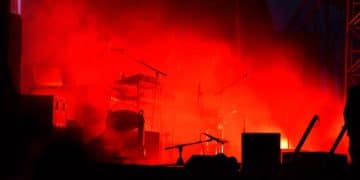Djent in 2025: Is It the Future of Progressive Metal?

Djent, characterized by its high-gain, palm-muted riffs and complex rhythms, faces scrutiny regarding its long-term viability in progressive metal, with its evolution and integration into broader metal genres crucial for its future relevance and innovation by 2025.
The progressive metal scene is constantly evolving, with new subgenres and techniques emerging all the time. One such subgenre that has gained considerable traction in recent years is Djent. But is Djent the Future of Progressive Metal? A 2025 Analysis of its Staying Power raises essential questions about its longevity and integration within the broader metal landscape.
Djent: Defining the Subgenre
Djent emerged in the late 2000s, characterized by its distinctive high-gain, palm-muted guitar riffs. This technique creates a percussive, syncopated sound that sets it apart from other metal subgenres. The name “djent” itself imitates the sound of the heavily distorted, low-frequency guitar chugs.
Beyond just a sound, djent incorporates complex rhythmic patterns and polyrhythms, often drawing influence from progressive metal and jazz fusion. Bands within this subgenre frequently utilize extended-range guitars (7, 8, or even 9-string) to achieve a broader tonal palette and explore lower registers.
Key Characteristics of Djent:
Djent’s evolution can be attributed to several factors. The advent of digital audio workstations (DAWs) made it easier for musicians to experiment with intricate rhythms and layering techniques. Additionally, the internet facilitated the sharing of techniques and ideas among guitarists worldwide.
- High-Gain, Palm-Muted Riffs: The foundation of the djent sound.
- Complex Rhythms and Polyrhythms: Creating intricate and unpredictable musical structures.
- Extended-Range Guitars: Allowing for lower tunings and extended tonal possibilities.
- Progressive Influences: Incorporating elements of progressive metal and jazz fusion.
In conclusion, djent’s unique sonic characteristics and innovative approach to rhythm have carved out a distinct space within the metal landscape. From its origins in bedroom studios to its proliferation on stages worldwide, djent has proven to be a notable force in modern metal. Its future, however, depends on further innovation and its ability to adapt and integrate with other genres.
The Rise of Djent: Key Bands and Albums
The djent subgenre has been propelled by a number of influential bands who have shaped its sound and gained a dedicated following. These bands have not only popularized the distinct djent style but have also pushed its boundaries, incorporating diverse musical elements and experimental techniques.
Several bands emerged early on, establishing the core elements that define djent. Meshuggah, often considered the pioneers of the subgenre, laid the groundwork with their complex rhythmic structures and down-tuned guitars. Other bands like Periphery, Tesseract, and Veil of Maya took these foundations and expanded upon them, adding their unique textures and approaches.

Pioneering Bands and Their Contributions:
Each band contributed significantly to the evolution of djent, introducing new elements and refining existing ones. Periphery, for instance, incorporated melodic elements and soaring vocals, while Tesseract explored atmospheric textures and progressive song structures.
- Meshuggah: Known for their complex rhythmic patterns and polyrhythms.
- Periphery: Introduced melodic elements and soaring vocals.
- Tesseract: Explored atmospheric textures and progressive song structures.
- Veil of Maya: Incorporated technical death metal influences, pushing djent into heavier territory.
In summary, the rise of djent is inextricably linked to the contributions of these key bands and their groundbreaking albums. Through their innovation and experimentation, they have solidified djent’s place as a significant force in modern progressive metal. As the subgenre continues to evolve, these bands serve as a foundation for future musicians looking to push the boundaries of djent even further.
Djent’s Influence on Modern Metal
Djent’s impact extends beyond its core fanbase, influencing various contemporary metal subgenres. Its rhythmic complexity and emphasis on technical proficiency have been integrated into deathcore, progressive metalcore, and even some mainstream metal acts, demonstrating djent’s widespread appeal and adaptability.
Numerous bands across different metal subgenres have adopted djent techniques, incorporating palm-muted riffs, complex rhythmic patterns, and extended-range guitars into their sound. This cross-pollination has resulted in hybrid styles that blend djent with other metal elements, creating innovative and distinctive music.
Examples of Djent’s Integration:
The integration of djent into deathcore and progressive metalcore has led to the emergence of new subgenres that combine the aggression of deathcore with the technicality and complexity of djent. Bands in these hybrid genres often feature breakdowns with djent-style riffing and incorporate progressive song structures.

- Deathcore: Some deathcore bands incorporate djent-style breakdowns and riffing.
- Progressive Metalcore: Progressive metalcore bands often integrate djent’s technicality and complexity.
- Mainstream Metal: Even some mainstream metal acts have adopted djent techniques.
In conclusion, djent’s influence on modern metal is undeniable. Its innovative techniques and rhythmic complexity have been embraced by bands across various subgenres, leading to the creation of hybrid styles and pushing the boundaries of metal music. As more musicians experiment with djent-inspired elements, its impact on the metal landscape is likely to continue growing.
Criticisms and Challenges Facing Djent
Despite its popularity, Djent is not without its critics and challenges. Some argue that the genre has become formulaic, with many bands adhering too closely to established tropes and lacking originality. Others find its emphasis on technicality over songwriting detrimental to the overall musical experience.
One of the primary criticisms leveled against djent is its perceived lack of innovation. As the subgenre has matured, some listeners feel that many bands are simply replicating the sounds and techniques of earlier djent pioneers without adding anything new or unique. This has led to concerns that the subgenre is becoming stagnant and losing its creative edge.
Key Criticisms of Djent:
The emphasis on technical proficiency in djent is also a point of contention for some listeners. While technical skill is undoubtedly a hallmark of the subgenre, some argue that it often comes at the expense of songwriting and emotional expression. This can result in music that is impressive from a technical standpoint but lacks memorable melodies or engaging compositions.
- Formulaic Sound: Many bands adhere too closely to established tropes, lacking originality.
- Technicality Over Songwriting: Emphasis on technical proficiency can overshadow songwriting quality.
- Lack of Dynamics: Some djent music is criticized for its relentless intensity and lack of dynamic variation.
- Overproduction: Heavily processed and quantized sound can strip the music of its natural feel and organic qualities.
In summary, the criticisms and challenges facing djent highlight the need for continued innovation and evolution within the subgenre. To maintain its relevance and appeal, djent must overcome issues such as formulaic songwriting, overemphasis on technicality, and lack of dynamic range. By addressing these concerns, djent can ensure its staying power and continue to push the boundaries of progressive metal.
Djent’s Evolution: Where Is It Heading?
Looking ahead to 2025, the future of djent hinges on its capacity for evolution and reinvention. The subgenre must embrace new influences, experiment with different sounds, and develop the next generation of innovative bands to remain relevant and exciting.
To avoid stagnation, djent needs to incorporate elements from other genres and subgenres. This could include integrating more melodic elements from progressive rock, incorporating electronic textures from synthwave, or borrowing rhythmic ideas from world music. By diversifying its sonic palette, djent can create a more dynamic and engaging listening experience.
Potential Avenues for Evolution:
One promising area for djent’s evolution is its intersection with other forms of art and technology. This could involve creating immersive live shows with visual projections and interactive elements, developing virtual reality experiences that allow listeners to explore djent music in new ways, or experimenting with artificial intelligence to generate unique compositions and textures.
- Integration of Melodic Elements: Incorporating more melodic hooks and vocal harmonies.
- Experimentation with Electronic Textures: Adding synth pads, electronic drums, and other electronic elements.
- Collaboration with Other Genres: Working with artists from different genres to create hybrid styles.
- Embracing New Technologies: Utilizing virtual reality, artificial intelligence, and other technologies to enhance the djent experience.
In conclusion, the future of djent is contingent on its ability to adapt, evolve, and embrace new influences. By diversifying its sound, experimenting with new technologies, and fostering a new generation of innovative bands, djent can ensure its continued relevance and cement its place in the history of progressive metal.
Djent in 2025: A Prediction
By 2025, djent will likely have evolved beyond its current form, incorporating diverse influences and styles to create a more dynamic and engaging sound. While some core elements of djent will remain intact, the subgenre will have diversified into various sub-styles, each with its unique characteristics.
In the coming years, we can expect to see djent bands experimenting with a wider range of instruments and textures. This could include incorporating more acoustic instruments, using unconventional sound effects, or collaborating with artists from different musical backgrounds. These experiments will help to broaden djent’s sonic palette and appeal to a wider audience.
The emphasis will shift from pure technicality to songwriting and emotional expression. As djent matures, bands will focus on crafting more memorable melodies, writing more engaging lyrics, and creating compositions that evoke a stronger emotional response. This will help to address criticisms that djent is too focused on technical proficiency and lacks emotional depth.
- Diversification of Sub-Styles: Different sub-styles with unique characteristics will emerge.
- Integration of Diverse Influences: Incorporation of elements from other genres.
- Emphasis on Songwriting: Focus on crafting memorable melodies and engaging lyrics.
- Use of New Technologies: Use of AI and VR.
In summary, djent’s survival and evolution depend on its ability to reinvent itself. While the core elements of djent will likely remain intact, the subgenre will need to diversify, incorporate new influences, and emphasize songwriting over pure technicality to remain relevant.
| Key Point | Brief Description |
|---|---|
| 🎸 Defining Djent | Characterized by palm-muted riffs and complex rhythms. |
| 🌟 Key Bands | Meshuggah, Periphery, and Tesseract have shaped the genre. |
| 🤔 Criticisms | Accusations of being formulaic and lacking originality. |
| 🚀 Future | Evolution and integration with other genres are crucial. |
FAQ
▼
Djent is characterized by its high-gain, palm-muted guitar riffs, creating a percussive and syncopated sound, often utilizing extended-range guitars for lower tunings and complex rhythmic patterns.
▼
Key pioneers include Meshuggah, often credited as the originators, along with Periphery, Tesseract, and Veil of Maya, who expanded djent’s sound with unique textures and progressive elements.
▼
Criticisms include the genre becoming formulaic, an overemphasis on technicality at the expense of songwriting, and a lack of dynamic variation, leading to a perceived stagnation.
▼
Djent’s techniques have been integrated into various subgenres like deathcore and progressive metalcore, resulting in hybrid styles that blend aggression with complexity, demonstrating its widespread adaptability.
▼
By 2025, djent is expected to evolve by incorporating diverse influences, styles, and technologies, diversifying into sub-styles with unique characteristics, while maintaining its core technical elements.
Conclusion
In conclusion, the question of whether djent is the future of progressive metal remains open. While it has had a significant impact and boasts dedicated fans, its future depends on its ability to evolve, innovate, and integrate with other genres. By addressing criticisms and embracing new influences, djent can secure its place as a lasting force in the progressive metal landscape.





